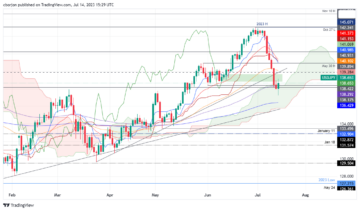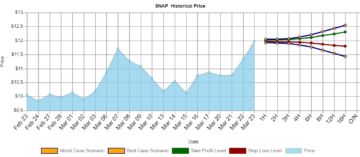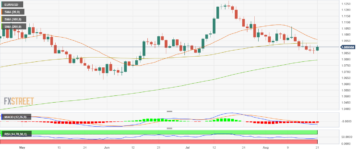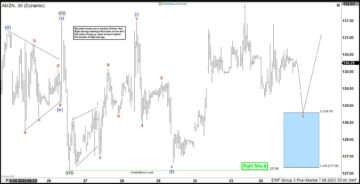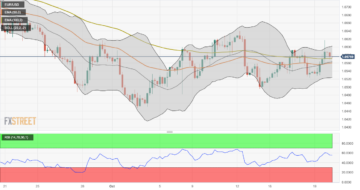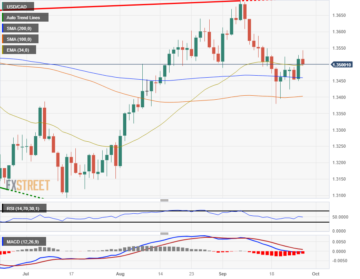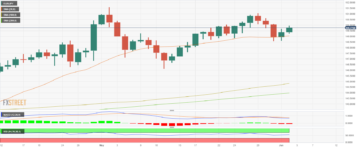
- The US Dollar trades mixed at the opening on Monday.
- Traders will likely keep powder dry for the main Fed event on Wednesday.
- The US Dollar Index resides above 105.00, struggling to make new highs.
The US Dollar (USD) eked out a ninth weekly close in the green, which means the US Dollar summer rally is turning into a late Indian one. Despite the strength, some signs are starting to mount that the rally might come to an end. Although last week got closed in the green for the USD, the University of Michigan inflation expectations components showed that participants believe the US Federal Reserve (Fed) should be nearly done hiking – and this isn’t good news for the Dollar.
The week presents a very light economic calendar that is unlikely to have much impact on current levels. Until Wednesday, some selling pressure is expected, particularly if the US Dollar is unable to break higher. This means that the US Dollar Index (DXY) is at risk of retreating, easing a touch away from a new six-month high.
Daily digest: US Dollar facing central bank week
- Plenty of central banks next to the Fed this week with Swiss, Norwegian, Swedish, Japanese and British central banks all set to issue rate decisions this week.
- Crude prices remain high on the bulleting board as WTI Crude printed a new yearly high at $90.84. The push in oil prices could mean that overall inflation remains elevated for the next quarter.
- There is a very light calendar on Monday, in a week in which the focal point will be the US Federal Reserve rate decision.
- The National Association of Home Builders will issue its Housing Market Index for September at 14:00 GMT. Expectations are for an unchanged number at 50.
- The US Treasury Department will auction a 3-month and a 6-month bill.
- Equities are a bit mixed, without a clear direction on Monday. Some disappointing comments from Societe Generale failing to impress investors is putting some selling pressure on European bank shares.
- The CME Group FedWatch Tool shows that markets are pricing in a 97% chance that the Federal Reserve will keep interest rates unchanged at its meeting in September after the recent PPI and Retail Sales numbers.
- The benchmark 10-year US Treasury bond yield trades at 4.35%, and peaked in early Monday trading.
US Dollar Index technical analysis: Easy start of volatile week
The Greenback had a bit of a rough ride, though the economic conditions compared to Europe and other countries still make it stand out and shine. This makes investors to still flock into the Greenback already for the high rates investors get paid out on the back of it. The question for this week will be if the US Dollar Index can stay above 105.00 even if the Fed delivers a rate pause.
The US Dollar Index (DXY) has edged up, reaching 105.41. This is just a sigh away from the 2023 high near 105.88. Should the DXY be able to close above there for the week, expect the US Dollar to go even stronger in the medium-turn.
On the downside, the 104.44 level seen on August 25 kept the Index supported on Monday, not allowing the DXY to sell off any further. Should the uptick that started on September 12 reverse and 104.44 gives way, a substantial downturn could take place to 103.04, where the 200-day Simple Moving Average (SMA) comes into play for support.
Central banks FAQs
Central Banks have a key mandate which is making sure that there is price stability in a country or region. Economies are constantly facing inflation or deflation when prices for certain goods and services are fluctuating. Constant rising prices for the same goods means inflation, constant lowered prices for the same goods means deflation. It is the task of the central bank to keep the demand in line by tweaking its policy rate. For the biggest central banks like the US Federal Reserve (Fed), the European Central Bank (ECB) or the Bank of England (BoE), the mandate is to keep inflation close to 2%.
A central bank has one important tool at its disposal to get inflation higher or lower, and that is by tweaking its benchmark policy rate, commonly known as interest rate. On pre-communicated moments, the central bank will issue a statement with its policy rate and provide additional reasoning on why it is either remaining or changing (cutting or hiking) it. Local banks will adjust their savings and lending rates accordingly, which in turn will make it either harder or easier for people to earn on their savings or for companies to take out loans and make investments in their businesses. When the central bank hikes interest rates substantially, this is called monetary tightening. When it is cutting its benchmark rate, it is called monetary easing.
A central bank is often politically independent. Members of the central bank policy board are passing through a series of panels and hearings before being appointed to a policy board seat. Each member in that board often has a certain conviction on how the central bank should control inflation and the subsequent monetary policy. Members that want a very loose monetary policy, with low rates and cheap lending, to boost the economy substantially while being content to see inflation slightly above 2%, are called ‘doves’. Members that rather want to see higher rates to reward savings and want to keep a lit on inflation at all time are called ‘hawks’ and will not rest until inflation is at or just below 2%.
Normally, there is a chairman or president who leads each meeting, needs to create a consensus between the hawks or doves and has his or her final say when it would come down to a vote split to avoid a 50-50 tie on whether the current policy should be adjusted. The chairman will deliver speeches which often can be followed live, where the current monetary stance and outlook is being communicated. A central bank will try to push forward its monetary policy without triggering violent swings in rates, equities, or its currency. All members of the central bank will channel their stance toward the markets in advance of a policy meeting event. A few days before a policy meeting takes place until the new policy has been communicated, members are forbidden to talk publicly. This is called the blackout period.
- SEO Powered Content & PR Distribution. Get Amplified Today.
- PlatoData.Network Vertical Generative Ai. Empower Yourself. Access Here.
- PlatoAiStream. Web3 Intelligence. Knowledge Amplified. Access Here.
- PlatoESG. Automotive / EVs, Carbon, CleanTech, Energy, Environment, Solar, Waste Management. Access Here.
- PlatoHealth. Biotech and Clinical Trials Intelligence. Access Here.
- ChartPrime. Elevate your Trading Game with ChartPrime. Access Here.
- BlockOffsets. Modernizing Environmental Offset Ownership. Access Here.
- Source: https://www.fxstreet.com/news/us-dollar-steadies-at-opening-of-fed-rate-decision-week-202309180808
- :has
- :is
- :not
- :where
- $UP
- 12
- 14
- 2%
- 2023
- 25
- 33
- 35%
- 36
- 41
- 50
- 84
- a
- Able
- above
- accordingly
- Additional
- Adjusted
- advance
- After
- ahead
- All
- Allowing
- already
- Although
- an
- analysis
- and
- Animate
- any
- appointed
- ARE
- AS
- Association
- At
- Auction
- AUGUST
- average
- avoid
- away
- back
- Bank
- Bank of England
- Bank of England (BOE)
- Banks
- BE
- been
- before
- being
- believe
- below
- Benchmark
- Benchmark Rate
- between
- Biggest
- Bill
- Bit
- board
- BoE
- bond
- boost
- Break
- British
- builders
- businesses
- by
- Calendar
- called
- CAN
- central
- Central Bank
- Central Banks
- certain
- chairman
- Chance
- changing
- Channel
- cheap
- clear
- Close
- closed
- CME
- CME Group
- come
- comes
- comments
- commonly
- Companies
- compared
- components
- conditions
- Consensus
- constant
- constantly
- content
- control
- control inflation
- conviction
- could
- countries
- country
- create
- crude
- Currency
- Current
- cutting
- Days
- decision
- decisions
- deflation
- deliver
- delivers
- Demand
- Department
- Despite
- Digest
- direction
- disappointing
- Dollar
- dollar index
- done
- down
- downside
- DOWNTURN
- dry
- Dxy
- each
- Early
- earn
- easier
- easing
- easy
- ECB
- Economic
- Economic Conditions
- economies
- economy
- either
- elevated
- end
- ends
- England
- Equities
- Europe
- European
- European Central Bank
- Even
- Event
- expanded
- expect
- expectations
- expected
- facing
- failing
- FAQ
- Fed
- Federal
- federal reserve
- Federal Reserve Rate Decision
- few
- final
- focal
- followed
- For
- Forward
- from
- further
- get
- gives
- GMT
- Go
- good
- goods
- got
- Green
- Greenback
- Group
- had
- harder
- Have
- her
- High
- higher
- Highs
- Hikes
- hiking
- his
- Home
- housing
- housing market
- How
- HTTPS
- if
- Impact
- important
- in
- independent
- index
- Indian
- inflation
- Inflation expectations
- Inflation remains elevated
- interest
- INTEREST RATE
- Interest Rates
- into
- Investments
- Investors
- issue
- IT
- ITS
- Japanese
- jpg
- just
- Keep
- kept
- Key
- known
- Last
- Late
- Leads
- lending
- Level
- levels
- light
- like
- likely
- Line
- live
- Loans
- local
- LOCAL BANKS
- Low
- low rates
- lower
- lowered
- Main
- make
- MAKES
- Making
- mandate
- Market
- Markets
- mean
- means
- meeting
- member
- Members
- Michigan
- might
- mixed
- module
- Moments
- Monday
- Monday Trading
- Monetary
- Monetary Policy
- monetary tightening
- MOUNT
- moving
- moving average
- much
- National
- Near
- nearly
- needs
- New
- new policy
- next
- Norwegian
- number
- numbers
- of
- off
- often
- Oil
- on
- ONE
- opening
- or
- Other
- out
- Outlook
- overall
- paid
- panels
- participants
- particularly
- Passing
- pause
- peaked
- People
- period
- Place
- plato
- Plato Data Intelligence
- PlatoData
- Play
- Play For
- Point
- policy
- politically
- Powell
- ppi
- presents
- president
- pressure
- price
- Prices
- pricing
- provide
- publicly
- Push
- Putting
- Quarter
- question
- rally
- Rate
- Rates
- rather
- reaching
- recent
- region
- remain
- remaining
- remains
- Reserve
- REST
- retail
- Retail Sales
- reverse
- Reward
- Ride
- rising
- Risk
- s
- sales
- same
- Savings
- say
- see
- seen
- sell
- Selling
- September
- Series
- Services
- set
- Shares
- shine
- should
- showed
- Shows
- Signs
- Simple
- SMA
- some
- speech
- speeches
- split
- Stability
- stand
- start
- started
- Starting
- starts
- Statement
- stay
- steady
- Still
- strength
- stronger
- Struggling
- subsequent
- substantial
- substantially
- summer
- support
- Supported
- sure
- Swedish
- Swings
- Swiss
- Take
- takes
- Talk
- Task
- Technical
- Technical Analysis
- that
- The
- the Fed
- The US Federal Reserve
- their
- There.
- this
- this week
- though?
- Through
- TIE
- tightening
- time
- to
- tool
- touch
- toward
- trades
- Trading
- treasury
- Treasury Department
- triggering
- try
- TURN
- Turning
- tweaking
- unable
- university
- University of Michigan
- University of Michigan Inflation Expectations
- unlikely
- until
- us
- US Dollar
- US Dollar Index
- US Federal
- us federal reserve
- US Treasury
- Us Treasury Department
- USD
- very
- volatile
- Vote
- want
- Way..
- Wednesday
- week
- weekly
- when
- whether
- which
- while
- WHO
- why
- will
- with
- without
- would
- WTI
- WTI Crude
- yearly
- Yield
- zephyrnet


